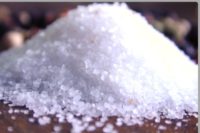Cutting Sodium in Canada
June 1/Ottawa/The Toronto Star -- In an attempt to lower the amounts of salt Canadians consume, Health Canada plans to call on the food industry to reduce substantially the amount of sodium in processed foods.
The Sodium Reduction Strategy, to be released in July, will rely on the industry to follow voluntary reduction targets aimed at slashing the average Canadian's daily consumption of sodium from 3,400mg to 2,300mg by 2016.
Public health officials, researchers and doctors have lauded the strategy -- coming almost three years after Ottawa convened a working group on the issue -- as a good first response to the mounting concern over salt in our daily diet. However, many also question whether voluntary sodium reduction targets go far enough in protecting Canadians from salt's harmful effects.
"It's hard to imagine at this stage how voluntary regulations in the long run would be sufficient," said Bruce Van Vliet, a cardiovascular researcher at St. John's Memorial University.
Dr. Marco Di Buono, director of research at the Heart and Stroke Foundation of Ontario, said the proposed targets for industry are not as aggressive as they should be to achieve the sodium reductions needed to protect Canadians' health. The health groups involved in the strategy have recommended an immediate reduction in sodium to an average of 2,300mg per day, with a goal of hitting 1,500mg per day over the next 10 years, he said.
"The targets that have been set for some of these core food stuffs that represent the bulk of sodium intake from prepackaged foods is in some cases only a 20% reduction," he said. "We need to go much further than the proposed targets if we are going to ultimately have an average sodium intake for all Canadians that is considered safe and healthy."
Dr. Hasan Hutchinson, director general of Health Canada's office of nutrition policy and promotion, laid out the strategy's details at a symposium on the issue organized by the Canadian Institutes of Health Research.
The strategy will:
* Publish voluntary targets for 10 of the highest sodium food groups, including bakery products, cereals, dairy products, processed meats, snacks, sauces and soups. The targets will list the maximum amount of sodium that can be included in 100g of food. For example, the proposed target for 100% whole wheat bread is 400mg of sodium or less per 100g.
* Define timelines and establish an outside agency to monitor progress. Health Canada expects industry to meet targets by 2016.
* Provide a plan to evaluate the program, which would include the option of implementing stronger measures, including regulatory legislation, if needed.
At the presentation, Hutchinson defended the voluntary strategy, saying that it would bring guidelines into play immediately. Stiffer regulations, he said, would ensure pushback from the food industry and take years to implement.
Kevin Willis of the Sodium Working Group said voluntary guidelines may lower sodium content in several highly salted food products, but regulatory rules likely will be needed to make a meaningful reduction in the long term.
The costs to the food industry in terms of retooling production lines, customer loss due to taste alteration and the loss of shelflife of some products will make top-down regulations essential to push manufactures into healthy compliance, said Willis, who heads the Canadian Stroke Network's sodium reduction campaign.
The 25-member working group, led by Health Canada, is comprised of health researchers and professionals, health-focused and consumer non-government organizations, the food manufacturing and food service industry and government.
Dr. Peter Liu, head of cardiovascular health at the Canadian Institutes of Health Research and a member of the working group, said voluntary guidelines are preferable because they can come into effect immediately and be posted for consumers to see.
Widespread knowledge of recommended sodium levels in targeted food groups will bring public pressure to bear on the companies that make them, Liu said.
"With regulation, it's a big fight. With pushback from industry, that could take three years to enact, and that's three years wasted."
From the June 7, 2010, Prepared Foods E-dition
Looking for a reprint of this article?
From high-res PDFs to custom plaques, order your copy today!




